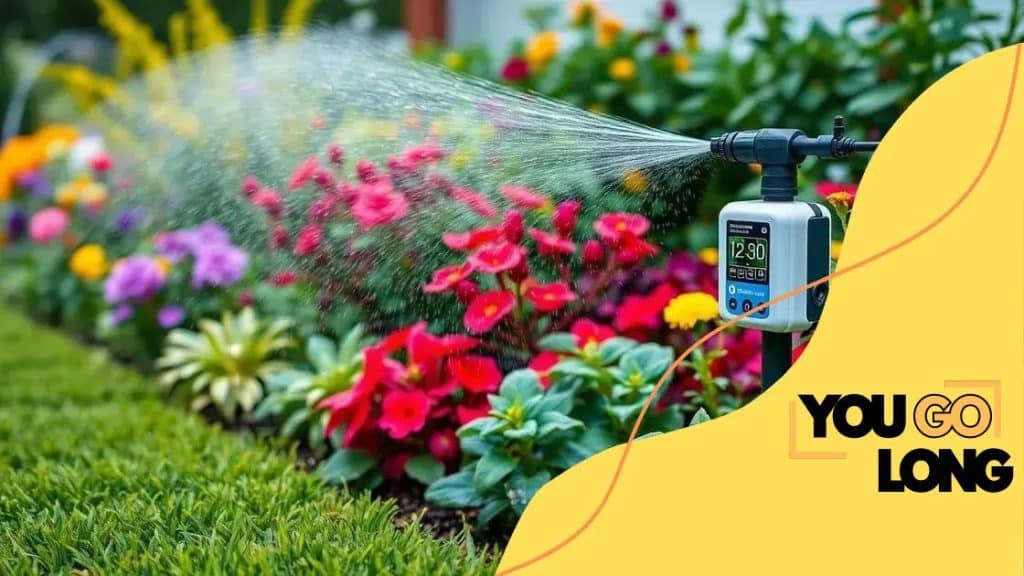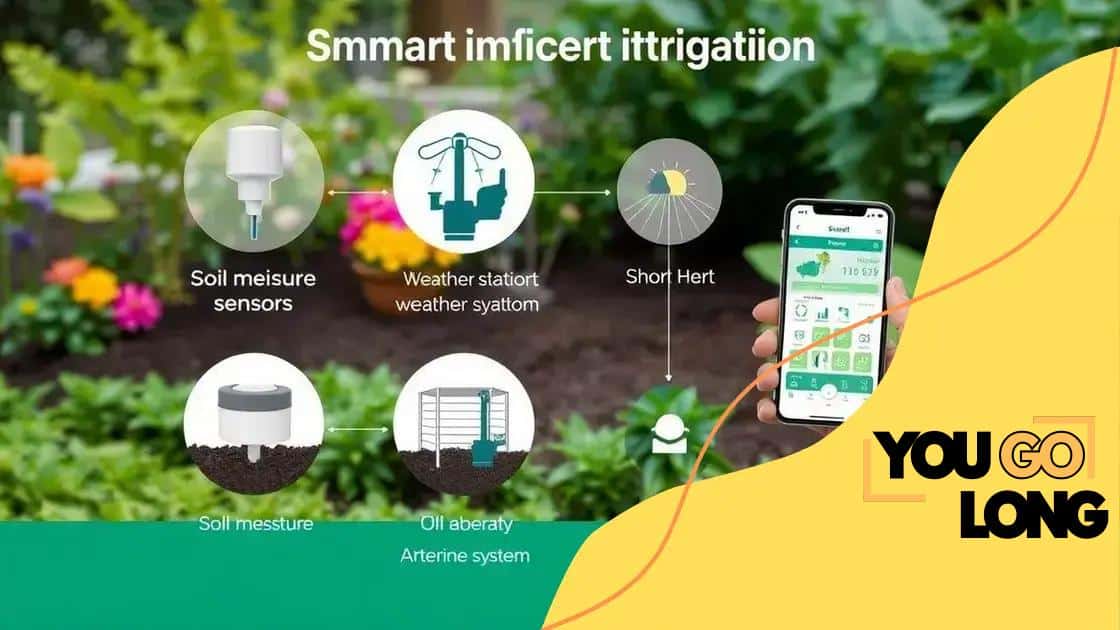The rise of smart irrigation systems in gardens

Advertisement
The rise of smart irrigation systems in gardens optimizes water usage through technology, ensuring that plants receive the right amount of moisture while conserving resources and improving growth efficiency.
The rise of smart irrigation systems in gardens is changing the gardening landscape. Have you noticed how gardens are becoming more efficient and sustainable? Let’s explore how these systems are making a difference.
Understanding smart irrigation systems
Understanding smart irrigation systems is essential for anyone looking to create a sustainable garden. These systems optimize water use by automatically adjusting to the needs of your plants, leading to healthier growth and less waste.
What Are Smart Irrigation Systems?
Smart irrigation systems incorporate technology to enhance traditional watering methods. They utilize sensors, timers, and Wi-Fi connectivity to determine when and how much to water. This ensures that plants receive the right amount of moisture at the right time, improving efficiency.
Advertisement
Key Features of Smart Irrigation
Several features make these systems stand out:
- Soil Moisture Sensors: These sensors detect moisture levels in the ground.
- Weather Adjustments: Many systems adjust watering schedules based on local weather forecasts, preventing overwatering on rainy days.
- Remote Access: Users can control their systems via smartphone apps, allowing for easy adjustments from anywhere.
By incorporating these features, gardens can thrive with less water, promoting environmental conservation.
Many gardeners are discovering the benefits of smart irrigation systems. These technologies not only save water but also reduce utility bills. Additionally, they help prevent plant diseases caused by overwatering.
Advertisement
As you explore smart irrigation, consider the different options available. Some systems are designed for specific types of gardens, while others are more universal. Understanding your needs will guide you in selecting the right system.
How smart irrigation improves water efficiency
How smart irrigation improves water efficiency is a crucial topic for anyone looking to conserve resources in their garden. These advanced systems ensure that plants receive the right amount of water without wastage.
Real-Time Monitoring
One of the standout features of smart irrigation systems is their ability to monitor soil moisture in real-time. Sensors are placed in the ground to provide accurate readings. This data helps to determine when to water, preventing both overwatering and underwatering.
Adaptive Scheduling
These systems also adapt watering schedules based on the season and weather conditions. For instance, during rainy days, they can delay the watering cycle, which conserves water and saves on utility bills.
- Weather Forecast Integration: Smart systems often connect to local weather services to adjust watering according to forecasted rain.
- Zone Management: Different areas of the garden need different amounts of water. Smart systems can manage various zones effectively.
- Historical Data Analysis: Utilizing past data allows systems to improve future watering schedules.
As gardeners adopt smart irrigation, they notice a significant reduction in water usage. This not only helps the environment but also lowers their watering costs.
Many users have reported healthier plants and more vibrant gardens due to proper moisture levels. The savings in water usage often lead to a quicker return on investment for the technology.
Ultimately, understanding how smart irrigation improves water efficiency is vital for those who wish to garden sustainably. The combination of technology and nature leads to flourishing environments.
Key technologies in smart irrigation

Key technologies in smart irrigation play a vital role in enhancing garden care and water efficiency. Understanding these technologies helps gardeners make informed choices about their watering systems.
Soil Moisture Sensors
One of the most important technologies is soil moisture sensors. These devices monitor the amount of water in the soil, sending real-time data to the irrigation system. This allows the system to water only when needed, conserving water.
Weather Stations
Integrating local weather data enhances the performance of smart irrigation systems. Weather stations measure rainfall, temperature, and humidity. By using this information, systems can adjust watering schedules automatically. For example, if rain is forecasted, the system can skip irrigation cycles.
- Rain Sensors: Detect rainfall and stop the watering system during wet conditions.
- Temperature Sensors: Help manage watering based on temperature fluctuations.
- Wind Sensors: Prevent water waste by stopping irrigation during high winds.
These features ensure that plants receive optimum moisture levels while reducing waste.
Another key technology is mobile app integration. Many smart irrigation systems allow users to control their settings through mobile applications. This means adjustments can be made remotely, ensuring your garden stays healthy even when you’re away.
Furthermore, some systems utilize advanced algorithms that analyze data over time. By understanding patterns in plant needs and local weather conditions, these systems fine-tune their schedules for maximum efficiency.
Integrating smart systems into your garden
Integrating smart systems into your garden can enhance the way you manage your plants and watering needs. This technology allows for better efficiency and healthier growth, making gardening more enjoyable.
Choosing the Right System
When selecting a smart irrigation system, consider the size of your garden and the specific needs of your plants. Some systems are tailored for small gardens, while others can manage larger landscapes. Understanding your garden’s layout is critical for effective integration.
Installation Process
The installation process varies depending on the system you choose. Most smart irrigation systems are user-friendly and can be installed without professional help. Start by setting up the main controller and connecting it to your Wi-Fi network. Then, install the moisture sensors in the soil.
- Step 1: Identify the areas that require watering.
- Step 2: Place sensors in multiple spots to get accurate moisture readings.
- Step 3: Connect the system to your smartphone app for easy management.
Once installed, you can monitor soil moisture levels and adjust watering schedules directly from your smartphone.
After setting up your system, regularly check for updates and calibrate the sensors as necessary. This will ensure that your smart irrigation system is working optimally, responding to changing conditions in your garden.
Integrating other smart technologies, like weather stations and temperature sensors, can provide even more precise control over your garden’s watering needs. These technologies work together to create an efficient watering schedule that saves water and keeps your plants healthy.
Future trends in garden irrigation technology
Future trends in garden irrigation technology promise to make gardening more efficient and sustainable. As technology evolves, new tools and methods emerge that can significantly improve how we water our gardens.
Automated Systems
One major trend is the rise of fully automated irrigation systems. These systems use advanced sensors and algorithms to control watering schedules without human intervention. They can adapt to changing weather patterns and plant needs, ensuring optimal moisture levels in the soil.
Data Analytics and AI
Data analytics and artificial intelligence (AI) are becoming integral to smart irrigation. These technologies analyze various data points, such as weather forecasts, soil moisture levels, and plant health. This analysis enables precise watering, reducing water waste and improving plant growth.
- Predictive Analytics: Systems can predict how much water a garden needs based on historical data and current conditions.
- Customizable Settings: Gardeners can set personalized watering schedules based on specific plant requirements.
- Remote Monitoring: Users can monitor their gardens from afar and make adjustments through mobile apps.
As these systems become more prevalent, gardeners can expect to see increased efficiency and reduced water consumption.
Another significant trend is the integration of renewable energy sources. Solar-powered irrigation systems are gaining popularity, providing an eco-friendly alternative that reduces reliance on traditional power sources. These systems help to minimize the carbon footprint of gardening.
Also, vertical gardening and urban farming techniques are influencing irrigation methods. As urban spaces often lack traditional garden setups, innovative irrigation solutions are emerging to cater to these environments, allowing more people to grow plants sustainably.
FAQ – Frequently Asked Questions about Smart Irrigation Systems
What are smart irrigation systems?
Smart irrigation systems use technology to automatically adjust watering based on plant needs and environmental conditions.
How do moisture sensors work in smart irrigation?
Moisture sensors detect the water content in the soil and send this data to the irrigation control system, ensuring efficient watering.
Can I control my irrigation system remotely?
Yes, many smart irrigation systems come with mobile apps that allow you to manage watering schedules and settings from your smartphone.
What are the benefits of using AI in irrigation technology?
AI helps analyze data for precise watering, predicts plant needs based on weather patterns, and optimizes water usage for healthier gardens.





